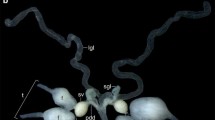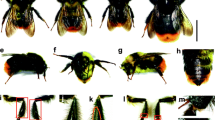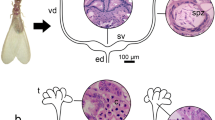Abstract.
In contrast to the many studies of external morphology of hymenopteran larvae little is known on internal morphology, and especially on the structure of the reproductive organs. This study describes a simple histological method which allows a very accurate (100%) determination of male and female individuals from the very first larval instar to the fourth instar in two formicoxenine ant species. Both female and male gonads are located between the fifth and sixth abdominal segments dorsodistal from the midgut. The male gonads are larger than the female ones throughout all larval instars, and have a heart-like shape formed by a small nucleus cell type (spermatogonia) organised into four or five lobes. In contrast, female gonads are round in cross-section and are formed by two types of cells, large nucleus cells (oogonia) and small nucleus cells (prospective follicle cells). Larval sexing is equally successful as in whole larvae when only the posterior part of the larvae is used, so that the anterior part is available for further studies on ploidy, genetics or others. Due to the accuracy and effectiveness of this method already in the first instar larvae, it is a true alternative to the methods used so far for primary sex ratio determination. All of them have higher error rates in determining sex ratio.
Similar content being viewed by others
Author information
Authors and Affiliations
Additional information
Electronic Publication
Rights and permissions
About this article
Cite this article
Ortius-Lechner, D., Rüger, M. & Wanke, T. Sexing at the larval stage in two ant species of the Formicoxenini (Hymenoptera). Zoomorphology 122, 41–45 (2003). https://doi.org/10.1007/s00435-002-0067-7
Received:
Accepted:
Issue Date:
DOI: https://doi.org/10.1007/s00435-002-0067-7




